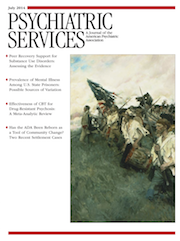There is great variation in estimates of the portion of incarcerated individuals who have mental illness. This wide variation is one of the main findings of the analysis by Prins (
1) of mental illness rates in U.S. state prisons. Since at least the 1930s, social observers such as Penrose (
2) have tracked the prevalence of mental illness in jails and prisons and have attempted to identify underlying clinical and social trends. In 2002, the first author and his colleagues questioned the presumption that the large number of incarcerated people with mental illness was attributable to failures in the assessment and treatment of mental illness and concluded that there is no reliable evidence that directing resources toward psychiatric treatment would have a significant impact on incarceration rates (
3). In this commentary, we argue that this conclusion remains true.
In the article by Prins (
1), the implied logic is that there is interpretive value in examining variations in the rates of mental illnesses in jails and prisons to discern the impact of psychiatric interventions. Holding to the principle that the most parsimonious explanation is best, the factor that explains the variation in the proportions of prisoners with mental illness is variation in correctional policy and practice among jurisdictions and over time, rather than variation in access to treatment for mental illness or in how mental illness is assessed or counted in prisons and jails. The more recent variation in rates of mental illness is also likely enhanced by the beginning of a shift in correctional policy: the decline of incarceration in prisons (
4).
Abramson (
5) laid the groundwork for examining connections between deinstitutionalization of psychiatric treatment and the rising number of incarcerated people with mental illnesses. Historically, institutions such as orphanages, poorhouses, and asylums have, each in their own time, experienced a profound increase in their populations, which was followed by a period of deinstitutionalization. Initially, the reasons given for deinstitutionalization are humane treatment, but eventually the most persuasive arguments center on cost and efficiency in state systems and the availability of plausible alternatives. In the United States, practice shifted from poorhouses to outdoor relief, charity movements, and social work; from orphanages to child welfare systems, foster care, and juvenile justice systems; from asylums to community mental health; and now from prisons to community corrections.
With the emergence of community corrections and the eventual downsizing of prisons and jails, many people with mental illness once incarcerated in conventional facilities will more often be involved in various forms of community corrections. Our colleague who is incarcerated in a community correctional facility (the first author met this person at a meeting outside of any prison or jail) would be counted as incarcerated by the local Department of Corrections (DOC). This person is free to pursue work in the daytime and does not receive health care through the DOC, unlike incarcerated persons in other kinds of facilities. Correctional health care policy focused on large prisons and jails has not caught up with the impact of deinstitutionalization in the provision of psychiatric care to vulnerable populations. As a result, a growing number of individuals with serious psychiatric disorders are left without reliable access to effective psychiatric treatment.
This commentary seeks to refocus attention away from efforts to establish a standard for rates of incarcerated persons with mental illness in conventional facilities with the aim of informing mental health interventions. The action is not there. The place for action in innovation, change, and planning is in community settings. Our goal should be to document variations across place and time in how the differences and changes in corrections practices interrupt effective care and to develop creative ways to recognize as a reality in the justice system the ongoing changes in corrections environments and the broad variation in incarcerated populations.

